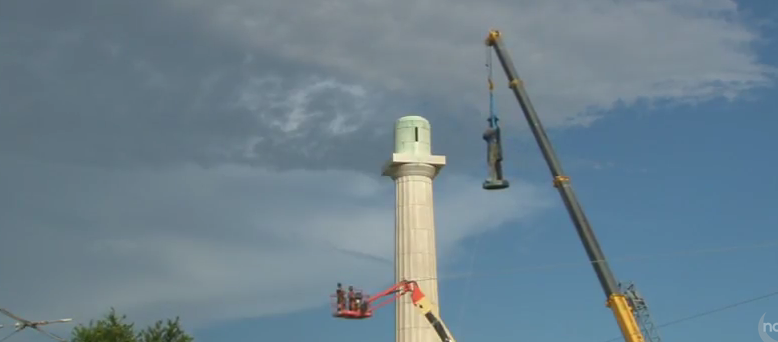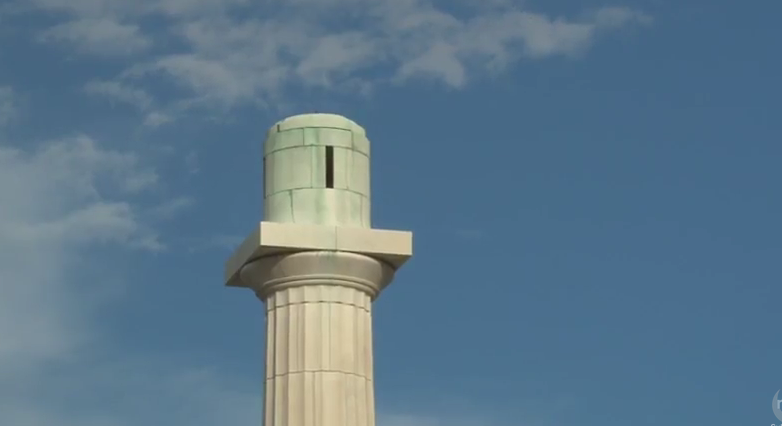This has been a fascinating couple of weeks in the world of Civil War memory. After removing the Liberty Place monument on April 24 the city of New Orleans removed three additional monuments to Jefferson Davis (May 11) and P.G.T. Beauregard (May 16-17). Yesterday Robert E. Lee was removed from high atop his perch in full daylight.
It’s too early to assess its significance in terms of its impact on debates in other communities across the country, but what we can say is that we have witnessed the serious crack in the Lost Cause and the most dramatic change to a major city’s Civil War commemorative landscape to date. Yesterday to mark the Lee Monument’s removal the Atlantic published my essay on why this particular monument is the most important. In short, compared to the other three Lee is a national icon, which makes his fall from grace the loudest.
Again, it is too early to tell what the impact may be, but in a piece I published in Smithsonian magazine on Thursday, I offer some reasons why Richmond, Virginia may dodge the kinds of sustained calls for removal heard in other cities. We shall see.
One final comment. Just to clarify, I am not an activist for the removal of Confederate or any other monuments. I have spoken passionately about Confederate monuments and their connections to white supremacy and Jim Crow and I will continue to do so, but I firmly believe that these decisions ought to be made by each community. After all, it was communities that chose to erect them.
That said, my thinking on this issue has evolved since the summer of 2015 and I have used this blog to explore my ideas as well as those of others. We are in uncharted territory and the subject deserves serious thought and even a willingness to take risks. I’ve done my best to add my voice and hopefully help others sift through their own ideas. As an educator that is all I can hope for.


A few hours ago, my city’s Confederate monument was vandalized with the word “SHAME.”
The statue also the only thing from the original Main Street still standing. Furthermore, it stands right in front of the Norfolk Southern corporate headquarters, which was William Mahone’s business. It would be a shame to lose it, especially when the cemetery already has a Confederate monument.
My solution, which I will present to the city if the statue is ever challenged, is to change “OUR CONFEDERATE DEAD” to “AMERICAN CIVIL WAR 1860-65.” Perhaps a brass plate cast and attached over the inscription, also covering the Confederate Flag on the reverse side.
I would, however, leave the Confederate seal and inscription marking the place where the last 3 living Confederates met in 1951. That should remain because it’s something so specific to that one spot in Norfolk. But inscriptions can be added for the Northern soldiers, including and especially USCT troops, who were first recruited at Fort Monroe in Norfolk.
As soon as I find out how to make a proposal, I’m taking this idea to the city.
I suspect that some people will consider your suggested changes to be another form of vandalism.
Seems to be a Southern thing … unyielding, uncompromising, and ultimately ensuring their own defeat. Shelby Foote was right.
There’s no way in heck these statues will remain. They have two options: either re-interpret them or watch them all be removed. It’s only a matter of time.
Orlando is moving a Confederate Statue from downtown to a cemetery and will also install an educational panel to give it historical context.
http://m.orlandoweekly.com/Blogs/archives/2017/05/16/orlandos-confederate-statue-will-be-repaired-moved-from-lake-eola
As an aging white southerner, I appreciate your willingness to shed light on the dark side of our widespread mythology surrounding Southern particularism. We’ve spend enough time–not to mention effort–saving our Confederate money, worshiping at Confederate shrines, and recreating the history of the Civil War to suit the liking of our most determined secessionist ancestors. The decades-long process of glorifying the inglorious has cost us dearly.
For white southerners, it is long past time to recognize that their closely held devotion to the Lost Cause stifled both economic and social progress. It made us smaller and meaner while expressing adoration for a glossy, sanitized vision of the Southern way of life. It is long past time for white and black southerners to join hands and declare, “Enough is enough.”
The Civil War has been over for more than a century and a half. We should be mourning the war itself, with its costs in life and treasure, but we should not mourn a fictionalized representation of southern culture and honor. We should celebrate the fact that the war ended the heinous practice of slavery, but we should mourn the fact that such an extreme conflict was necessary to bring about that end. We should be ashamed of the fact that we used the war and the misguided sentiments around it to create a new form of slavery under segregation, Jim Crow, and generations of poverty for both whites and blacks.
I see the removal of each of these monuments as evidence that at long last white southerners are coming to terms with the fact that Civil War is over–and that the Confederacy and all it stood for has been so much bad baggage. With this cancer finally contained, maybe–just maybe–the South can channel its energy into creating a diverse culture that deserves our pride.
Thanks for taking the time to leave such a thoughtful comment.
“In short, compared to the other three Lee is a national icon, which makes his fall from grace the loudest.”
“but I firmly believe that these decisions ought to be made by each community. After all, it was communities that chose to erect them.”
Those two statements seem to contradict each other.
You are going to have to explain why you believe they contradict. Thanks.